Programming has become as fundamental as reading and writing in the rapidly evolving digital world. It’s no longer reserved just for computer scientists; it’s a critical tool across many professions and an excellent method for fostering problem-solving skills in young minds.
For parents eager to set their children on the path to success, introducing them to the basics of programming—specifically sequences, selections, and loops—is an invaluable step. These three fundamental programming structures form the backbone of all programming languages and are crucial for building basic instructions and algorithms that power software. Understanding these components is at the heart of ‘Programming Essentials Unveiled: The Art of Sequences, Selections, and Loops,’ a guide designed to demystify these concepts and show how integral they are to mastering the programming landscape.
What is Programming?
Programming is the art of creating instructions that tell a computer how to perform tasks. These tasks can range from solving simple problems to creating complex games and developing versatile apps. Learning to program arms children with a vital skill set increasingly necessary in the job market of tomorrow.
Sequences, Selection, and Loops
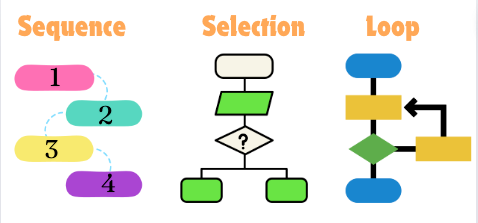
Sequences in Programming
1.What is Sequences?
Sequences are fundamental in programming because they set the foundation for more complex operations. In real-world programming tasks, sequences are used to perform tasks like initializing an application, processing user inputs, and sequentially executing steps that update the application’s state.
While seemingly straightforward, sequences are vital as they teach logical progression in tasks. For children, understanding sequences is akin to following a recipe or completing a series of steps in a math problem, fostering a logical and systematic approach to problem-solving.
2.Importance of Sequencing
By learning sequencing, children develop the ability to plan and execute tasks efficiently. This skill is crucial not just in programming, but also in daily activities and future professional tasks.
3.Example of Sequencing
Consider programming a robot to make a sandwich. The steps might be:
- Take two slices of bread.

- Spread butter on one slice.
- Add a slice of cheese.
- Cover with the second slice of bread.
This process of following a series of steps in a specific order to achieve a desired outcome is similar to sequencing in programming, where instructions are executed in the order they are written.
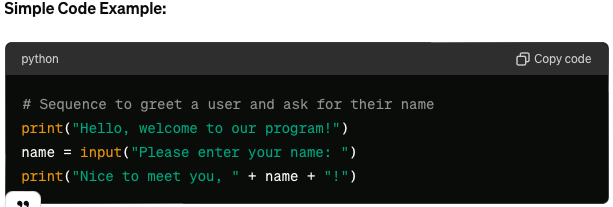
Explanation: This simple Python sequence starts by printing a greeting, then prompts the user for their name, and finally prints a personalized greeting. Each step is executed in the exact order it appears.
Selections in Programming
1.What is Selections (decision-making structures)?
Selections, or decision-making structures, allow programmers to control the flow of a program based on conditions. This introduces children to conditional logic, essential for making decisions within software. This is crucial in applications like data analysis, where different data ranges may require different processing methods, or in user interfaces where the output depends on user choices.
2.Importance of selections
Learning to make decisions through programming teaches children to implement rules that guide software behavior, mirroring real-life decision-making processes.
3.Example of Selection: Choosing What to Wear
Imagine you’re getting ready for a day out. You open your wardrobe and decide what to wear based on the weather outside. If it’s a sunny day, you might choose to wear a T-shirt and shorts. If it’s raining, you might opt for a raincoat and boots. Your choice of outfit depends on the condition outside, and you make a decision based on that condition.

In this example:
- You evaluate the weather condition (sunny, rainy, etc.).
- Based on the weather condition, you select an appropriate outfit from your wardrobe.
This process of selecting an outfit based on a condition (in this case, the weather) is similar to a selection in programming, where different actions are taken depending on whether a condition is true or false.
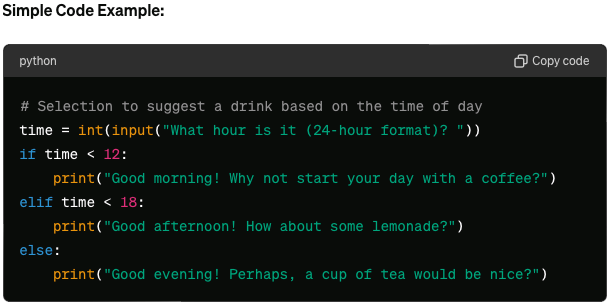
Explanation: This example checks the current time and uses conditional statements (if, elif, else) to print beverage suggestions appropriate for the morning, afternoon, or evening.
Loops/Iteration in Programming
- What is a Loop (repeating structure)?
Loops are programming structures that repeat a set of instructions until a certain condition is met, allowing for efficient management of repetitive tasks. Loops make code more efficient and easier to maintain.
- Importance of Loops
The Power of Loops Understanding loops is crucial for tasks that require repetition, such as processing lists or continuous user input, making programming more efficient and reducing the likelihood of errors.
- Example of a Loop – Making Breakfast
Imagine you’re making breakfast and you need to toast multiple slices of bread. You put a slice of bread in the toaster, wait for it to toast, take it out when it’s done, and then repeat the process for the remaining slices of bread. This repetitive process of toasting multiple slices of bread until you’ve toasted them all is similar to how a loop works in programming.
In this example:
- You start with the first slice of bread.
- You put it in the toaster.
- You wait for it to toast.
- You take it out when it’s done.
- Then, you move on to the next slice of bread and repeat the same steps until you’ve toasted all the slices.

This process of repeating the same steps for each slice of bread until you’ve processed them all is analogous to a loop in programming, where a set of instructions is repeated a certain number of times or until a condition is met.
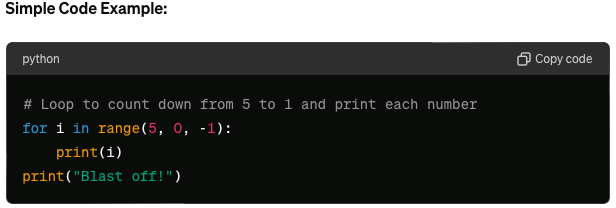
Explanation: This for loop in Python counts down from 5 to 1, printing each number. After exiting the loop, it prints “Blast off!” This example is simple but illustrates how loops handle repetitive tasks without manually writing the instructions multiple times.
Mini Project – The Magical Pet Adventure
| Objective: | Introduce the basics of programming (sequences, selections, loops) through a fun and interactive pet simulator. |
| Instructions:
|
· Introduction (5 minutes):
Þ Explain that programming is like giving instructions to a computer. Þ Discuss the three basic programming structures: sequences, selections, and loops. · Pet Simulator Creation (15 minutes): Þ Guide your child to create a new Scratch project. Þ Show them how to add a sprite (e.g., a cat) and a backdrop. Þ Have them create a sequence of blocks to make the pet move. · Creating Pet Commands (10 minutes): Þ Introduce selections by adding blocks that allow the pet to respond to different commands (e.g., meow if hungry). Þ Encourage them to experiment with different sequences, selections, and loops to create unique pet behaviours. |
| Test Understanding:
|
· Observe your child’s ability to create and program their pet simulators.
· Check their understanding of sequences, selections, and loops.
|
Whiskers’ Magical Tale
You wake up one morning, feeling a bit restless and bored. Suddenly, you hear a faint meow coming from the corner of your room. As you turn to look, a small, fluffy kitten appears out of nowhere, its eyes sparkling with curiosity.
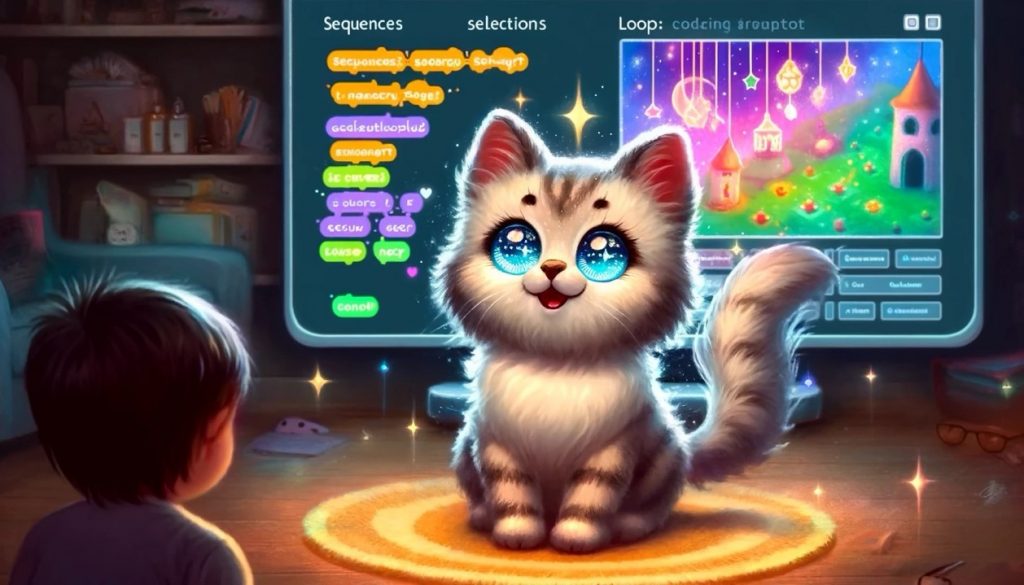
“Hello there!” the kitten says in a tiny voice. “My name is Whiskers, and I’m a magical pet from the land of Code-ilia. I’ve come to take you on an exciting adventure where you’ll learn the secrets of programming.”
Whiskers flicks her tail, and a large computer screen materializes in front of you.
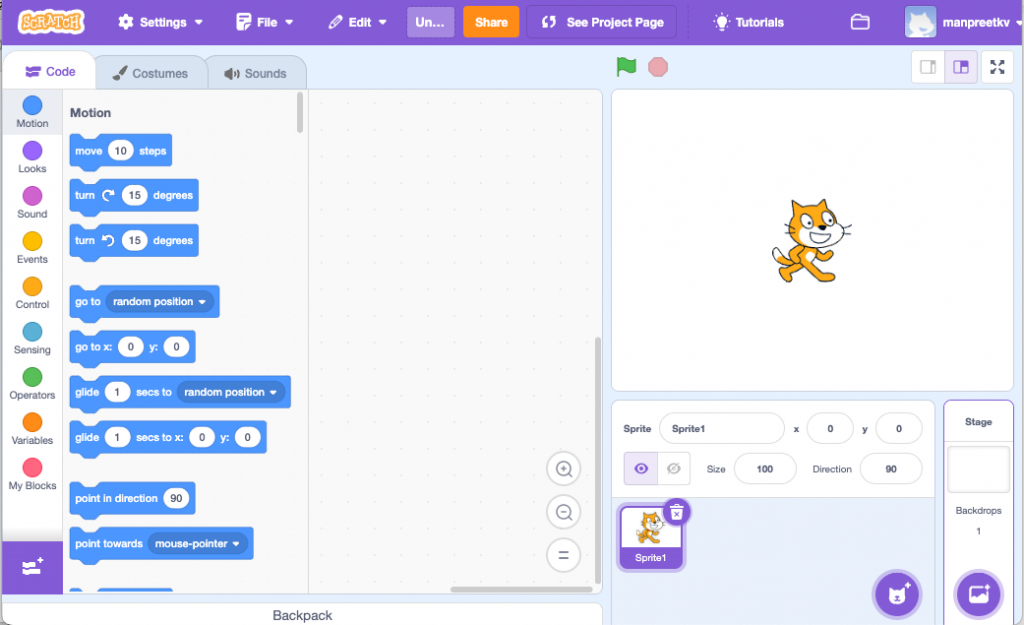
“This is the Scratch Realm, where we’ll create our very own pet simulator,” she explains. “But first, we need to understand the three basic rules that govern this world: sequences, selections, and loops.”
Sequences, Whiskers tells you, are like a series of instructions that must be followed in a specific order. She demonstrates by making herself walk across the screen, one step at a time.
Next, she introduces selections, which allow you to make choices based on certain conditions. “If I’m hungry, I’ll meow,” Whiskers says, and sure enough, a loud meow echoes through the room when her belly rumbles.
Finally, Whiskers demonstrates loops, which allow you to repeat a set of instructions over and over again. She starts chasing her tail in a circle, going round and round until you tell her to stop.
“Now it’s your turn!” Whiskers exclaims.
- Use the Scratch Realm to create your very own pet simulator.
- Choose a sprite—maybe a dog, a bird, or even a mythical creature.
- Give it commands to follow.
- Make it move, respond to your voice, and even perform tricks.
As you start building your simulator, Whiskers guides you through the process, reminding you to use sequences, selections, and loops to make your pet come to life. With each new command you add, your pet becomes more lifelike and interactive.
Before you know it, you’ve created a fully-fledged pet simulator, complete with unique behaviours and quirky personalities. Whiskers nuzzles up against you, purring with delight. “You’ve done it!” she says. “You’ve unlocked the secrets of programming and brought your very own virtual pet to life.”
With a flick of her tail, Whiskers disappears, leaving you with a newfound appreciation for the world of coding and a deep sense of accomplishment.
10 Tips for Parents to Spark Their Child’s Interest in Coding
Encouraging your child to learn programming is a fantastic way to foster their creativity, problem-solving skills, and logical thinking abilities.
Here are some tips for parents to help their child build interest in coding:
- Start Early: Introduce your child to programming concepts early on, as young as elementary school age. There are plenty of resources available for children, such as games and apps that teach coding basics in a fun and engaging way. Look into coding classes for kids or computer programming for kids to find suitable options.
- Provide Resources: Invest in resources like children’s programming books, educational websites, and coding kits designed for kids. These resources often use visual programming languages or block-based coding interfaces that are easier for beginners to understand. You can also explore online coding classes for kids for structured learning.
- Lead by Example: Show your child that programming is a valuable skill by sharing stories about how coding is used in various industries, from video game development to scientific research. If you have programming experience yourself, consider coding alongside your child as a bonding activity.
- Encourage Exploration: Let your child explore different programming languages and projects to find what interests them most. Whether they’re interested in building websites, creating games, or programming robots, there’s something for everyone in the world of coding.
- Celebrate Achievements: Celebrate your child’s coding milestones, no matter how small. Whether they successfully debugged a program or completed their first coding project, praise their efforts and encourage them to keep learning.
- Make it Fun: Keep coding sessions enjoyable by incorporating games, challenges, and creative projects. Encourage your child to think outside the box and come up with their own coding ideas.
- Emphasize Problem-Solving: Help your child develop problem-solving skills by encouraging them to break down complex problems into smaller, more manageable parts. Teach them how to use resources like online forums and tutorials to find solutions to coding challenges.
- Support Perseverance: Programming can be frustrating at times, especially when things don’t work as expected. Encourage your child to persevere through challenges and learn from their mistakes. Remind them that even experienced programmers encounter bugs and setbacks.
- Provide Opportunities for Collaboration: Encourage your child to collaborate with friends or join coding clubs and workshops where they can work on projects with peers. Collaboration can develop teamwork skills and provide valuable learning opportunities.
- Expose Them to Real-World Applications: Show your child how coding is used in real-world scenarios by exploring projects and innovations in fields like robotics, artificial intelligence, and app development. This can help them see the practical applications of their coding skills.
By following these tips and providing a supportive environment, you can help your child develop a lifelong passion for programming and technology. If you’re looking for structured learning, consider enrolling them in coding classes for kids or exploring online coding classes for beginners.
Discover SkoolOfCode
Looking for top-notch, structured coding classes for kids and dynamic online coding sessions?
Look no further than SkoolOfCode. Designed to cater to various age groups and skill levels, SkoolOfCode offers a diverse range of courses, ensuring an interactive and enjoyable learning experience for all.
Whether your child is taking their first steps into the world of programming or aiming to refine their existing skills, SkoolOfCode has something for everyone. From programming for beginners to advanced learners, each course emphasizes practical applications in a supportive and nurturing environment.
With our comprehensive resources and expert guidance, success is just a click away.
Conclusion
Programming is more than just a technical skill; it’s a gateway to logical thinking, problem-solving capabilities, and creativity. By mastering sequences, selections, and loops, children can gradually build a solid programming foundation that will empower them to innovate in the tech-driven future. With SkoolofCode’s tailored curriculum, your child can embark on this exciting coding journey with confidence.
Ready to Start Your Child’s Coding Journey?
Explore the exciting world of programming by signing up for SkoolOfCode’s coding classes for kids online today. With our tailored curriculum that fits all ages and skill levels, your child will be on the path to becoming a programming whiz. Don’t wait, visit SkoolOfCode to discover more about our best coding classes for kids and help your child start building a successful future in tech.
Ms.Manpreet Virk, an educator at SkoolOfCode with a degree in M.Phil and Master in Computer Science. She is passionate about learning and teaching young minds.

